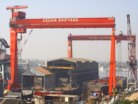 ET Now
ET Now
In a chat with ET Now, Sanjeev Prasad, Senior Executive Director & Co-Head at Kotak Institutional Equities, shares his thoughts on the market. Excerpts:
ET Now: Experts feel that in the next two weeks, markets are going to see a fresh high - 7900 is the number that they are quoting. Do you also get the feeling that the markets are on their way to a fresh high?
Sanjeev Prasad: I do not know about the short term, but in the more medium term, the markets will do well as long as our economy keeps expanding and earnings growth keep coming through. There is very little to indicate that the market will go higher. So I am not going to comment on the way it is going to be in two weeks.
But it is a growing market in the sense of earnings growth - we are looking at about 13 to 14 per cent growth over the next two years. Accordingly, you can look at the market two years down the line - may be about 35 per cent higher from where we are.
ET Now: Is the fundamentals set up supportive for the market move?
Sanjeev Prasad: Again, I do not know about the short term. It will depend on how the monsoon plays out. The monsoon was good last week and hopefully that will continue this week also.
What is more important is whether we have the set up in place for further growth in the market in the next two years and the answer is a definite yes.
What we are seeing are seeds being sown for higher GDP growth in the next two years. Perhaps 2015 is going to become more subdued at around 5.5 per cent and 2016 could pick up to about 6 per cent. But 2017 onwards - once we have seen the real fruits of fiscal consolidation, the efforts which have been unleashed by the government in the current budget and also the previous government to some extent, some of the initiatives that have been taken on the investment and manufacturing side, etc - hopefully will translate into lower interest rate and higher GDP growth.
Hence, I would not be surprised to see the GDP growth somewhere in the range of 7 per cent by fiscal 2017 and the fiscal deficit coming down to 3 per cent by fiscal 2017.
ET Now: Do you not worry about this universal optimism that things will only improve - both on a local account and on a global account? India seems to be a crowded and a popular trade.
Sanjeev Prasad: That may be correct, but things are moving in the right direction. Keep in mind the fact that India is coming out of a cyclical low as far as growth is concerned. Last two years have seen a subdued GDP growth, constrained by a very weak macroeconomic position. But if you look at the macroeconomic situation, things have already improved to a large extent.
When it comes to the external situation, current account and BoP are very healthy as of now. For 2015, we are looking at 1.5 per cent current account deficit to GDP; fiscal deficit starting to improve compared to much higher numbers. With substantial efforts on improving fiscal position further, whether it is with respect to GST implementation or whether it is for the fuel subsidy forms, the fiscal situation can only improve from where we are.
Coming to the inflation part, we are now on a downward trajectory. Maybe still not sufficient for the RBI to act, but if things continue, hopefully over the next, say, nine months, if you have a somewhat loser monetary policy.
When it comes to growth, we are coming of a low cyclical base if monsoons do not play spoil sport this year. We are seeing some strong pick up on the manufacturing side. If you look at the IIP numbers for April-May, there are decent numbers over there.
If the government puts in the right economic measures for investment reforms and manufacturing investment, things can only improve from where we are.
ET Now: The initial set of numbers, which have come out, is largely from the IT space. Do you think we are off to a good start for this earnings season?
Sanjeev Prasad: It looks like that. But you should also keep in mind the fact that some of the earning numbers have been supported by changes to the depreciation rate. Thus, even if there is a beat in the net level, it is coming more because of lower depreciation numbers compared to what analysts have factored in because of the change in depreciation rates as specified by the New Companies Act. But in general, numbers seem to be coming out reasonably well at the EBITDA level.
ET Now: Do you think the gas price issue - still being unresolved - would be a deterrent to Reliance’s stock price?
Sanjeev Prasad: We have a positive view on the stock now. About a week or so ago, we have again made it an add from our reduced rating earlier - target price of 1090. So, no real change there. What came out in the results were not so much as the operating numbers, which were pretty much in line with what we had at the EBITDA level. Hence, there is some surprise on the interest income side and interest expense side which was marginally lower than what we had assumed. The depreciation side also turned out to be lower. So the beat came more because of numbers below the EBITDA level.
More importantly, if you look at the noncore businesses - shale and retailing, both which have started showing very decent numbers - the market is going to take that positively.
It still remains an overhang on the telecom side. Some people are not really as negative as what they used to be earlier. The large investment which Reliance is doing currently can pay dividend at some point in time. All that put together and if you extrapolate the earning numbers to around 17, you are looking at a big step up in earning numbers. We are looking at somewhere about Rs 90 for 2017. Hence, it is a fair value without giving any value for the telecom business. That is somewhere about Rs 80 of investment already made by Reliance. As of now, we are giving zero value for that.
Hence, I would not be too surprised if whenever 2017 numbers start getting discounted - maybe it is still 18 months down the line - the stock could be in the range of around 1250-1300 quite easily, assuming you do not see some bad news on the telecom side.
Coming to the gas price issue, my views always have been that India has no option but to give higher gas prices to domestic companies. No matter who they are - whether it is a private company, public company, foreign company or domestic company - it does not really matter.
The choice is either we pay $15 per million Btu to the likes of Australia and Qatar and get LNG into India or we give the right price, whatever that may be, $8 to $10 per million Btu to our own companies and expect that production will increase over a period of time because of more investment in the E&P side.
I do not know why there is so much of debate on this basic point. Otherwise, they should start controlling prices of all commodities in this country, which is a disaster. We have been part of a socialist model for so long and look at what has happened to the country eventually. Hence, the faster they move forward to market pricing for everything, the better it is for the country.
ET Now: Last time, you were talking about how Tata Motors is looking interesting. You also spoke about your bullish view on Hero MotoCorp as well as Maruti Suzuki. Does that stay?
Sanjeev Prasad: Yes, very much. These are good long term stories. Penetration levels of all two wheelers or four wheelers are still low in India and as economic recovery takes place, you will see demand coming back strongly. Ultimately, that just plays on economic growth.
Also, as and when interest rates get cut, that could unleash another level of demand as far as autos are concerned. Hence, I continue to be very positive on the entire auto space. Tata Motors is not an India play, but there we are more excited about the new launches which Tata Motors would bring on stream from fiscal 2016. We are looking at something like 28 per cent volume growth in 2016.
ET Now: Cement has been a performing group, but last week, we have learnt that cement companies across the board have taken a price cut of about Rs 5 to Rs 15 per bag. What does that mean and what are your thoughts on cement stocks?
Sanjeev Prasad: That is not surprising because typically you will see a price decline in the monsoons. This time around, the monsoons have got pushed back. Hence, it is inevitable that construction will slow down in the monsoon season. This is a seasonal phenomenon and every year you see the same thing repeating.
Coming to the valuations and the stocks, we are quite positive about the fact that you will see profitability improving from where it is currently, as also volumes recovering as India invests more in the basic infrastructure sector as also housing. I do not think there is any doubt about volume growth in any sector as far as India is concerned, but even if I build in pretty high profitability for the cement companies for 2016, even in the stocks that are trading at somewhere about 21-22 times March 2016 earnings which look rather expensive for a cement company, at that kind of valuations, I would rather be buying an FMCG company at maybe slightly higher valuation, but on a price to free cash flow. The FMCG companies would be a lot cheaper compared to the cement companies. It is more of a valuation call over here. We find it very expensive currently.
Sanjeev Prasad: We are playing this through the auto space. If you see the last two-three years, demand has gone nowhere for passenger cars. It has been a very subdued growth for motorcycles - not so much for two wheelers which have seen a decent growth. As and when you see economic recovery and consumption demand coming back, auto sector should do well, helped by maybe lower interest rates after perhaps the next nine months.
We are not very positive on consumer staples, but there are some pockets which we do like. For example, Dabur is showing a very strong across the board volume growth.
ET Now: What is the sense that you are getting about the banking pack? It has been a silent rally this time around.
Sanjeev Prasad: This is a sector which will keep on expanding as the nominal GDP growth. Thus, it is a somewhat excellent play on the GDP expansion. Banking is also a good play on consumption plays because as and when you start seeing consumption demand picking up, etc. that will also play out for the banking stocks. Also, as and when you see more of investments coming through the infrastructure side picking up, credit growth will also pick up. Hopefully the NPL problems would not be as severe as what was anticipated at one point of time.
There is now a roadmap towards how some of these issues can be resolved. You have a situation where credit growth could pick up from where we are. Maybe NIMS will not expand, but NPL problems would hopefully be lower. Put all that together and this is a sector which will do very well over the next five years.
ET Now: Soon FDI limits in insurance, defence and in railways would move up. Are you excited about this idea? If yes, which sector will benefit the most if FDI limit is increased?
Sanjeev Prasad: The idea of opening up any FDI or sector to more FDI investment is great because India requires money when it comes to investment. But in railways, it would not be in operations. I am not sure how FDI will play a role in the railways if it is not going to be in the operations.
49 per cent in defence is a bit iffy. Foreign companies are happy getting into a JV where they have to share technology with Indian companiesm but not in control of the company, because if you look at the FDI inflation here, the control in management has to be with Indian companies. Hence, we are there but not fully there to some extent.
Insurance is probably the best bet when it comes to the market, because that is where you have a number of companies who could benefit because of FDI limit going up from 26 to 49 per cent. Especially if the RBI insists on the transaction, many of which were supposed to fructify at pre-decided valuations or at much lower valuation, then the current market value, whatever that may be, of the insurance business could really provide a big fillip to the valuations of the Indian insurance companies. Particularly Bajaj Finserv should benefit because there, the alliance could increase the stake from 26 to 49 per cent at very low prices or the pre-decided price compared to what is the real fair value of Bajaj Alliance Life Insurance at this point in time.










 Get Unlimited Access to The Economic Times
Get Unlimited Access to The Economic Times
